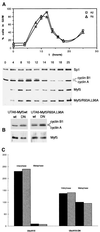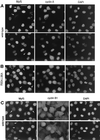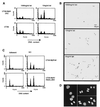Constitutive instability of muscle regulatory factor Myf5 is distinct from its mitosis-specific disappearance, which requires a D-box-like motif overlapping the basic domain
- PMID: 11073992
- PMCID: PMC86547
- DOI: 10.1128/MCB.20.23.8923-8932.2000
Constitutive instability of muscle regulatory factor Myf5 is distinct from its mitosis-specific disappearance, which requires a D-box-like motif overlapping the basic domain
Abstract
Transcription factors Myf5 and MyoD play critical roles in controlling myoblast identity and differentiation. In the myogenic cell line C2, we have found that Myf5 expression, unlike that of MyoD, is restricted to cycling cells and regulated by proteolysis at mitosis. In the present study, we have examined Myf5 proteolysis through stable transfection of myogenically convertible U20S cells with Myf5 derivatives under the control of a tetracycline-sensitive promoter. A motif within the basic helix-loop-helix domain of Myf5 (R93 to Q101) resembles the "destruction box" characteristic of substrates of mitotic proteolysis and thought to be recognized by the anaphase-promoting complex or cyclosome (APC). Mutation of this motif in Myf5 stabilizes the protein at mitosis but does not affect its constitutive turnover. Conversely, mutation of a serine residue (S158) stabilizes Myf5 in nonsynchronized cultures but not at mitosis. Thus, at least two proteolytic pathways control Myf5 levels in cycling cells. The mitotic proteolysis of Myf5 is unlike that which has been described for other destruction box-dependent substrates: down-regulation of Myf5 at mitosis appears to precede that of known targets of the APC and is not affected by a dominant-negative version of the ubiquitin carrier protein UbcH10, implicated in the APC-mediated pathway. Finally, we find that induction of Myf5 perturbs the passage of cells through mitosis, suggesting that regulation of Myf5 levels at mitosis may influence cell cycle progression of Myf5-expressing muscle precursor cells.
Figures






Similar articles
-
Failure of Myf5 to support myogenic differentiation without myogenin, MyoD, and MRF4.Dev Biol. 2000 Mar 15;219(2):287-98. doi: 10.1006/dbio.2000.9621. Dev Biol. 2000. PMID: 10694423
-
Delta 1-activated notch inhibits muscle differentiation without affecting Myf5 and Pax3 expression in chick limb myogenesis.Development. 2000 Dec;127(23):5213-24. doi: 10.1242/dev.127.23.5213. Development. 2000. PMID: 11060246
-
The myogenic basic helix-loop-helix family of transcription factors shows similar requirements for SWI/SNF chromatin remodeling enzymes during muscle differentiation in culture.J Biol Chem. 2002 Sep 13;277(37):33818-24. doi: 10.1074/jbc.M205159200. Epub 2002 Jul 8. J Biol Chem. 2002. PMID: 12105204
-
Subunits and substrates of the anaphase-promoting complex.Exp Cell Res. 1999 May 1;248(2):339-49. doi: 10.1006/excr.1999.4443. Exp Cell Res. 1999. PMID: 10222126 Review.
-
Control of mitotic transitions by the anaphase-promoting complex.Philos Trans R Soc Lond B Biol Sci. 1999 Sep 29;354(1389):1583-90. doi: 10.1098/rstb.1999.0502. Philos Trans R Soc Lond B Biol Sci. 1999. PMID: 10582244 Free PMC article. Review.
Cited by
-
P311 induces a TGF-beta1-independent, nonfibrogenic myofibroblast phenotype.J Clin Invest. 2002 Nov;110(9):1349-58. doi: 10.1172/JCI15614. J Clin Invest. 2002. PMID: 12417574 Free PMC article.
-
Pax3 regulation of FGF signaling affects the progression of embryonic progenitor cells into the myogenic program.Genes Dev. 2008 Jul 1;22(13):1828-37. doi: 10.1101/gad.477908. Genes Dev. 2008. PMID: 18593883 Free PMC article.
-
Whole-exome sequencing and genome-wide association studies identify novel sarcopenia risk genes in Han Chinese.Mol Genet Genomic Med. 2020 Aug;8(8):e1267. doi: 10.1002/mgg3.1267. Epub 2020 Jun 1. Mol Genet Genomic Med. 2020. PMID: 32478482 Free PMC article.
-
Pax3 and Pax7 have distinct and overlapping functions in adult muscle progenitor cells.J Cell Biol. 2006 Jan 2;172(1):91-102. doi: 10.1083/jcb.200508044. Epub 2005 Dec 27. J Cell Biol. 2006. PMID: 16380438 Free PMC article.
-
A distinct profile of myogenic regulatory factor detection within Pax7+ cells at S phase supports a unique role of Myf5 during posthatch chicken myogenesis.Dev Dyn. 2009 Apr;238(4):1001-9. doi: 10.1002/dvdy.21903. Dev Dyn. 2009. PMID: 19301399 Free PMC article.
References
-
- Albagli O, Lantoine D, Quief S, Quignon F, Kerckaert J, Montarras D, Pinset C, Lindon C. Overexpressed BCL6 (LAZ3) oncoprotein triggers apoptosis, delays S phase progression and associates with replication foci. Oncogene. 1999;18:5063–5075. - PubMed
-
- Arnold H-H, Winter B. Muscle differentiation: more complexity to the network of myogenic regulators. Curr Opin Genet Dev. 1998;8:539–544. - PubMed
-
- Auradé F, Pinset C, Chafey P, Gros F, Montarras D. Myf5, MyoD, myogenin and MRF4 myogenic derivatives of the embryonic mesenchymal cell line C3H10T1/2 exhibit the same adult muscle phenotype. Differentiation. 1994;55:185–192. - PubMed
Publication types
MeSH terms
Substances
LinkOut - more resources
Full Text Sources
Research Materials
Miscellaneous
